20 Czech Christmas Traditions – Discovering the Magic of Christmas
I always enjoy celebrating my Christmas in Prague, especially the weeks before when you get to soak up the Christmas atmosphere by walking in the town, visiting Christmas exhibitions, markets and, of course, at home, baking Christmas cookies, making my own festive advent wreath and decorating our Christmas tree with old-fashioned glass ornaments.
Christmas celebrations in the Czech Republic are a bit different from the UK or USA – we celebrate Christmas on Christmas Eve, presents are also shared on the same evening and they are brought to you by the little baby Jesus (not a Santa Claus…).
PIN TO KEEP FOR LATER

We also don’t get stockings on Christmas day, because we get them (or mainly children) on the 6 December instead! Our dinner is a ‘magnificent feast’ of fried carp with cold potato salad (sadly the remnants of communist times…) which usually results in a higher intake of patients with stuck fish bones in their throat at the local emergency hospital.
But joking aside, there are some lovely customs and folk traditions that many people still follow and the best thing is that every family has their own way of celebrating Christmas.
I hope you enjoy reading about the 20 different Czech Christmas customs, their origins, and how they are celebrated today and perhaps it inspires you to add them to your own family celebrations.
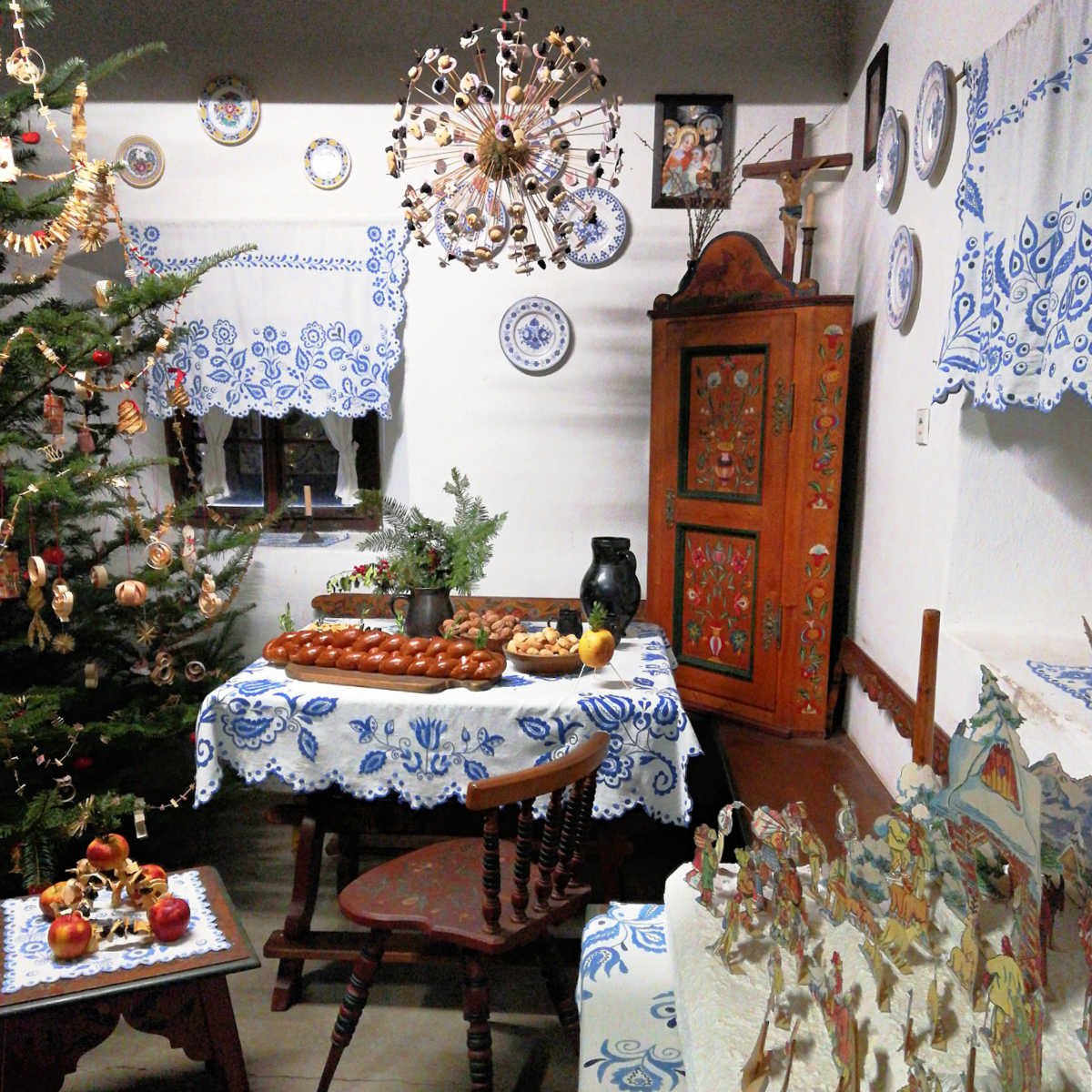
1. Celebrating St. Nicholas Day on 5 December
Celebrating St. Nicholas Day is probably one of the few originally folk traditions that has survived to this day. In the evening on the 5th of December you can see St. Nicholas walking around dressed in a traditional bishop’s hat, cloak and long white beard.
As a symbol of good and evil, he is accompanied by devils and angels and together they walk around and ask children if they have been good last year and give them sweets and other little treats.
You can see official and unofficial St. Nicholas processions in Prague on 5th December. Parents usually arrange for St. Nicholas to stop by and bring the children their treats.
On the 6th of December, children usually wake up super early and it’s a custom that they have a Christmas stocking hanging on the window or door handle filled with sweets, nuts, dried fruits, oranges, bananas, tangerines and small gifts.
It’s also a custom to get a large potato or lump of coal if you’ve been not so good (or parents put one in anyway, to scare children a little).
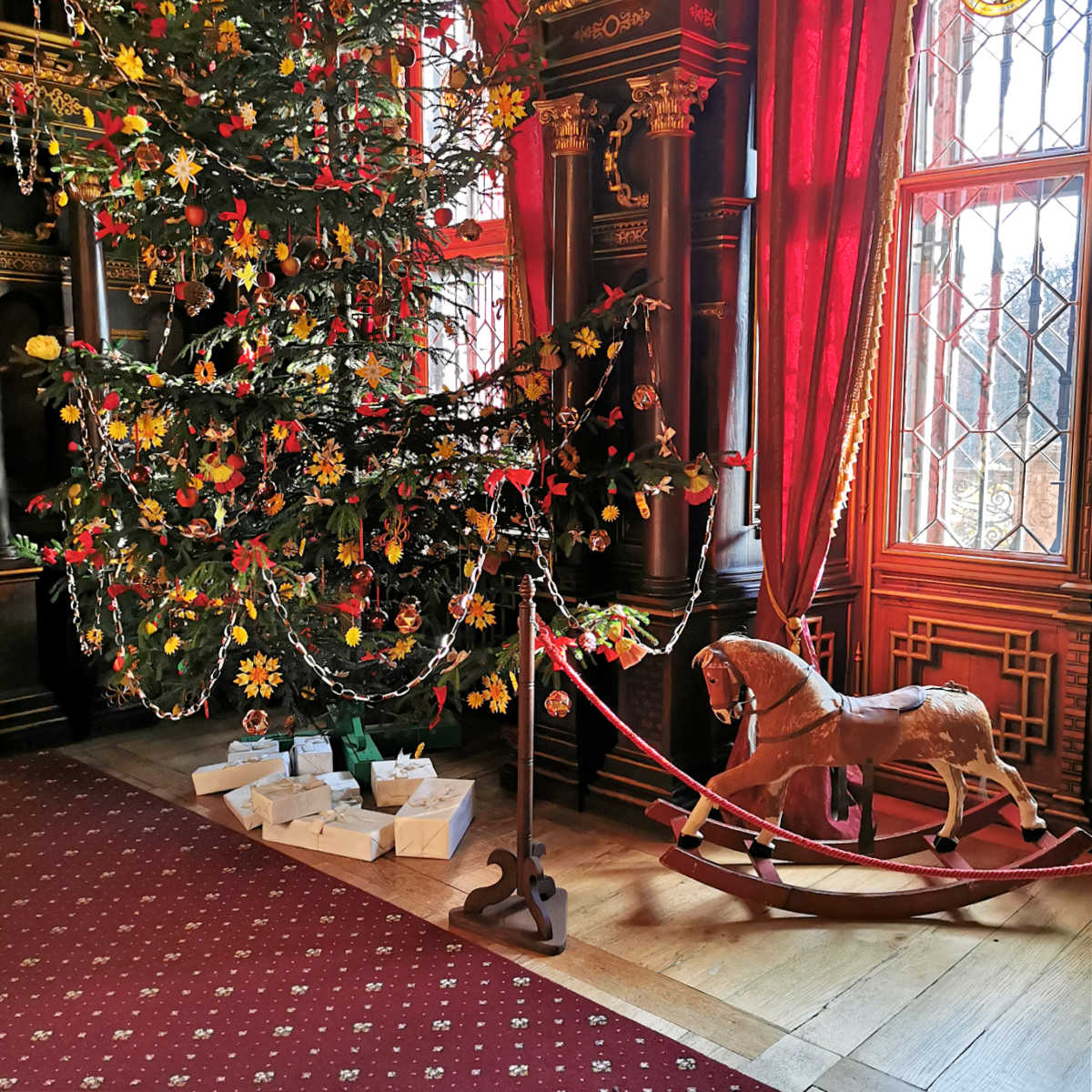
2. Christmas Tree
It wouldn’t be a Christmas without a Christmas tree. The decorated Christmas tree, around which families gather and under which they find gifts on Christmas Eve, is an essential part of Czech Christmas. A lot of families still choose to have a real tree, usually a conifer – spruce, pine or fir – and decorate it with traditional glass-blown decorations, handmade decorations and Christmas lights.
The custom of decorating Christmas Tree in the Czech Republic or rather Bohemia at the time was started by the director of the Estates Theatre in Prague, Jan Karel Liebich, who had a tree decorated in 1812 as a surprise for a pre-Christmas dinner party for his friends.
The tradition was adopted by other wealthy families and gradually spread to ordinary households. It was a great hit, because, by around 1850, the Christmas tree was already being written about as a tradition, although at the time only in the bigger towns.
The trees were decorated with dried apples and plums, nuts, gingerbread, and sweet pastries, as well as ribbons. The star at the top was then a symbol of hope and enlightenment.

3. Mistletoe
A sprig of mistletoe is part of any house Christmas decoration and is hung so that it is possible to walk under it or kiss under it. A couple who kisses under the mistletoe will have a love for the whole next year. If you give mistletoe to someone, it will protect them from illnesses and bring luck to the house.
Legend has it that the wood of the mistletoe tree (in legends, it is said that mistletoe was a separate tree) was used to make the cross of Christ. The tree then withered in shame and turned into a plant that is supposed to redeem Christ’s suffering by bringing happiness to anyone who is gifted with it.

4. Nativity Scene
The Nativity scene shows the birth of Jesus Christ in the manger, surrounded by Mary and Joseph, a donkey, an ox, shepherds with their flock of sheep, and three kings. The traditional nativity scenes were made from wood and the more affordable from paper.
Apart from seeing the nativity scene at Christmas Markets, churches and Christmas celebrations, it’s still quite common for people to have a set at home (usually paper one) to display as part of their home decorations.
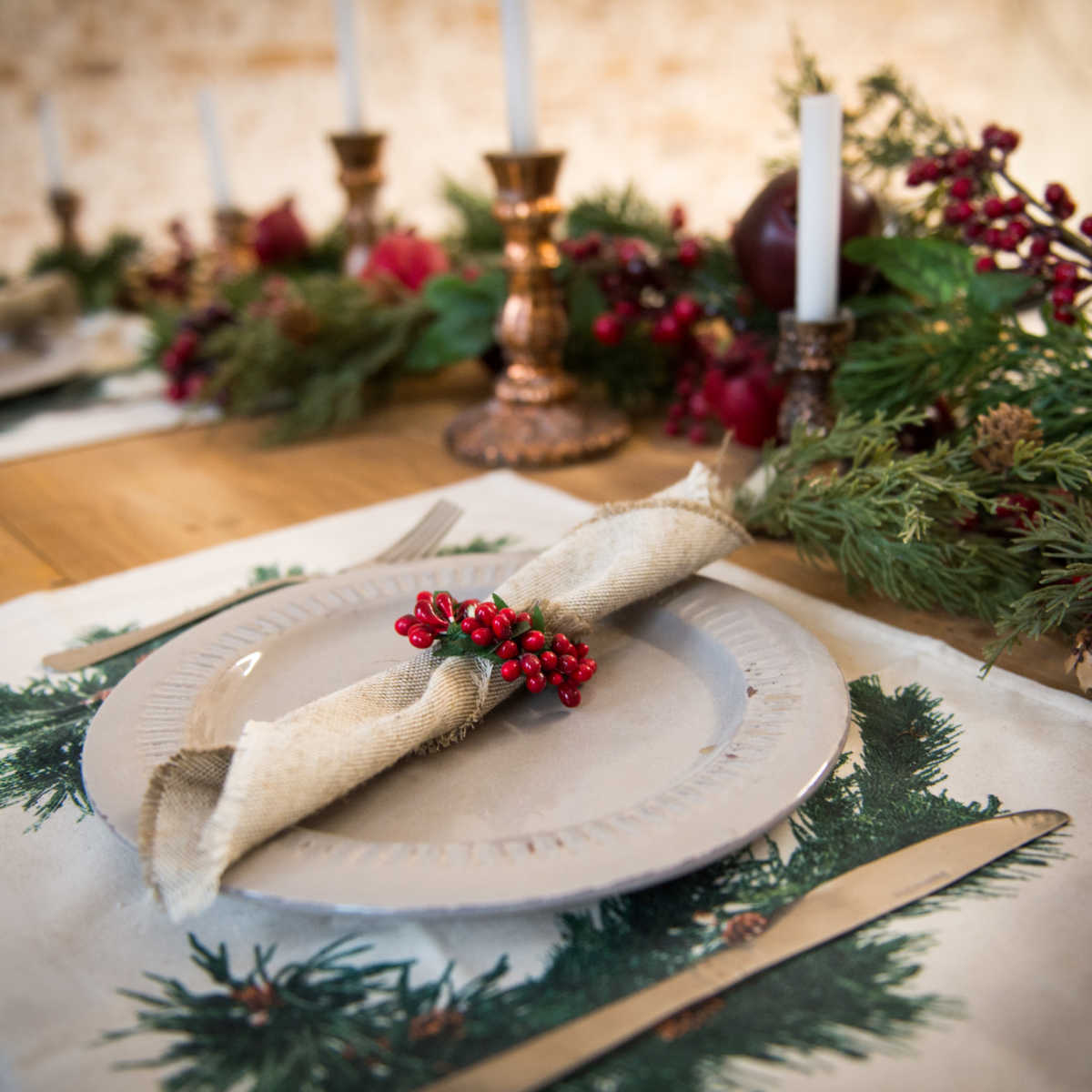
5. Christmas Eve Celebrations
Christmas is traditionally celebrated on the 24 December, which is Christmas Eve. Until fairly recently (and some people still do this now), the Christmas tree would be decorated in the morning, whilst the TV is on with a constant flow of Christmas fairy tales or radio with Christmas carols.
We would also display Christmas cookies on the trays and place them around the house. For breakfast, we would have a sweet bread called Vanocka with chicory coffee for children and real coffee for adults.
Families would prepare early dinner, which is normally served around 4 or 5 pm. And after dinner, everyone would gather around the Christmas tree and open their presents. There is always a new fairy tale made each year, which is shown on Czech television in the early evening and the whole family watches it together.
A little fun fact for you – Christmas Eve is not a public holiday or day off, it’s a normal working day! But over the years, offices started to close a little earlier on Christmas Eve to allow people to start their Christmas celebrations. Most shops are open until evening, although usually not beyond 5 or 6 pm, unless it’s a small corner shop.

6. Christmas Carp
Traditionally, the main part of Christmas dinner is fried carp, but this tradition is relatively modern. In 1920’s a famous Czech recipe writer Magdalena Dobromila Rettigova added a recipe for fried carp in her cookery book and people (mainly from the towns) started to prepare this dish as part of the Christmas feast.
But it wasn’t until the 1950s and 1960s when the communist government popularised the dish so much that it became a ‘national Christmas dish’. At the same time, they promoted the chilled potato salad as a side dish. Until then the fried carp would be served with boiled potatoes or other hot side dishes. I mean, why would anyone want to combine hot fried fish with a cold side dish?
Well, it turns out that the communist government thought that it would be good for the working women to prepare something quick and easy for dinner, since 24 December was a regular working day!
In the week running up to Christmas, you can still see fresh carp being sold at various Christmas markets around Prague. Some people still take the carp home to put into the bath and keep it there until 24 December. I always liked that because, not only did we have a pet for a few days, but we also didn’t need to have a bath every night, because the carp was in it!
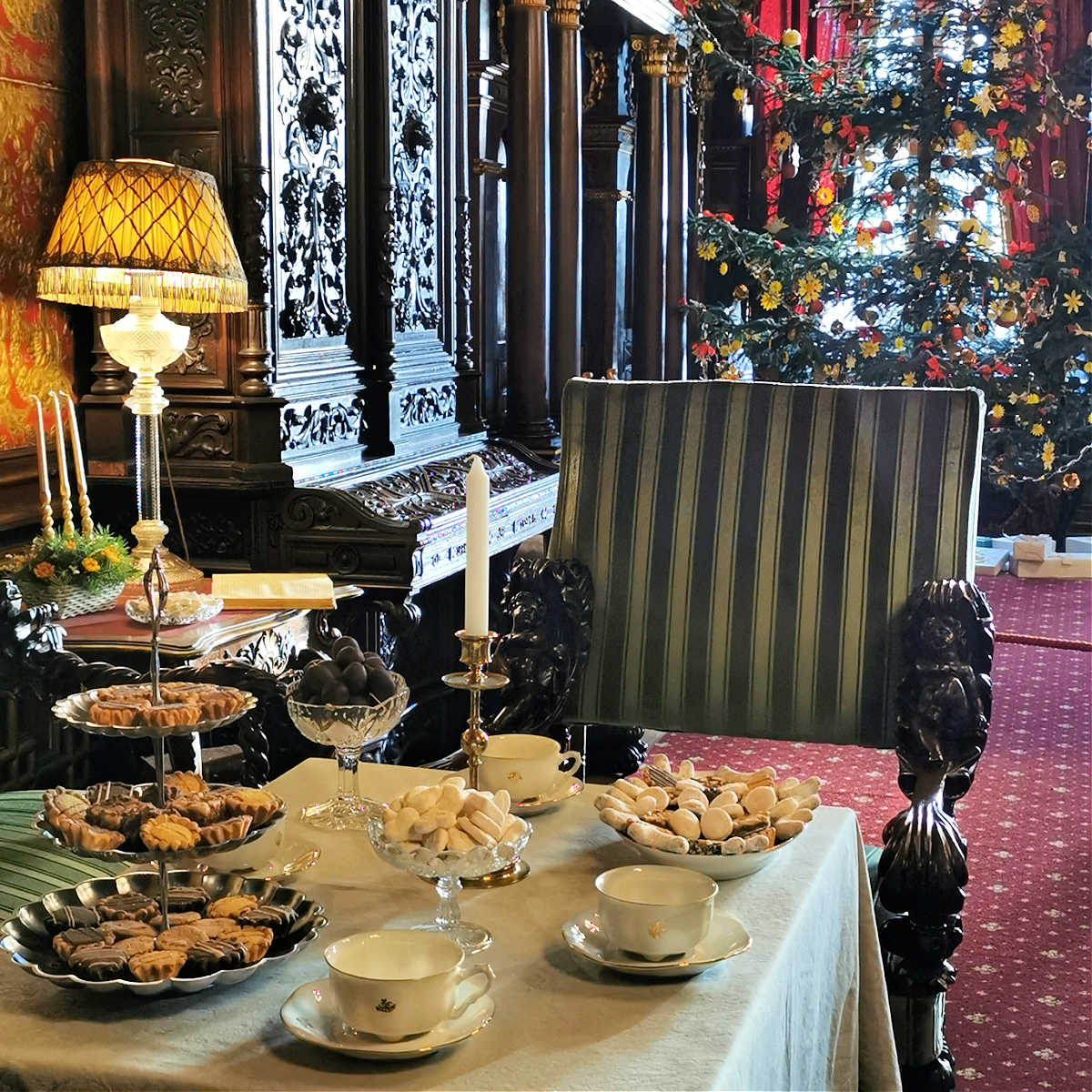
7. Christmas Eve Dinner
The traditional Christmas dinner is a fish soup followed by a fried carp with potato salad. This combination can be called a modern classic, which you can try as one of the Christmas foods and drinks available in Prague during the festive time.
On the table of our ancestors, you would mainly find porridge made of millet, peas, or barley, bread, legume soup, and later also fish. The traditional dish was Christmas kuba or hubnik (a dish made from mushrooms). Instead of cookies, there was dried fruit and honey. Meat was forbidden for a long time, as well as alcohol.
The ‘afters’ or pudding is the Christmas Cookies or more ‘Vanocka’ and there is no specific hot pudding, like in the UK.
If you like to follow the tradition, you would set the table for one extra person. This is to symbolise that you welcome any unexpected guests and that they can join you and your family for the evening.
Another traditional ‘rule’ is that during the dinner, no one is allowed to get up from the table until everyone finishes eating. According to superstition, whoever gets up during the dinner will not sit with the others at the table next year (meaning that they might be away but also not live to see the next Christmas!)
Sometimes people would tie the legs of the table together with a chain or rope to make sure that the family would stay together.

8. Midnight Mass
Midnight mass is a very special mass that mostly starts at midnight, although some churches start at 11 pm on Christmas Eve 24 December. There are also usually services in the afternoon on the 24 December for the children and also on the 25 December as it’s the Second Christmas Day.
There are many beautiful churches in Prague, where you can take part in special Christmas services or just visit during the day for a quiet contemplations.

9. Christmas Cookies
Baking Christmas cookies is one of the most widespread Christmas traditions in the Czech Republic. Each family has their own recipes, but some of the most popular cookies include Linzer cookies, vanilla crescents, decorated gingerbread, walnut biscuits shaped like bear paws, beehive-shaped cookies filled with egg nog filling and many more.
I remember there was always friendly competition about how many types of cookies each family would bake and the numbers would run to 10 or even 15 types! The tradition, however, is to have at least 7 different types of cookies, although I’m not sure that everyone follows that these days.
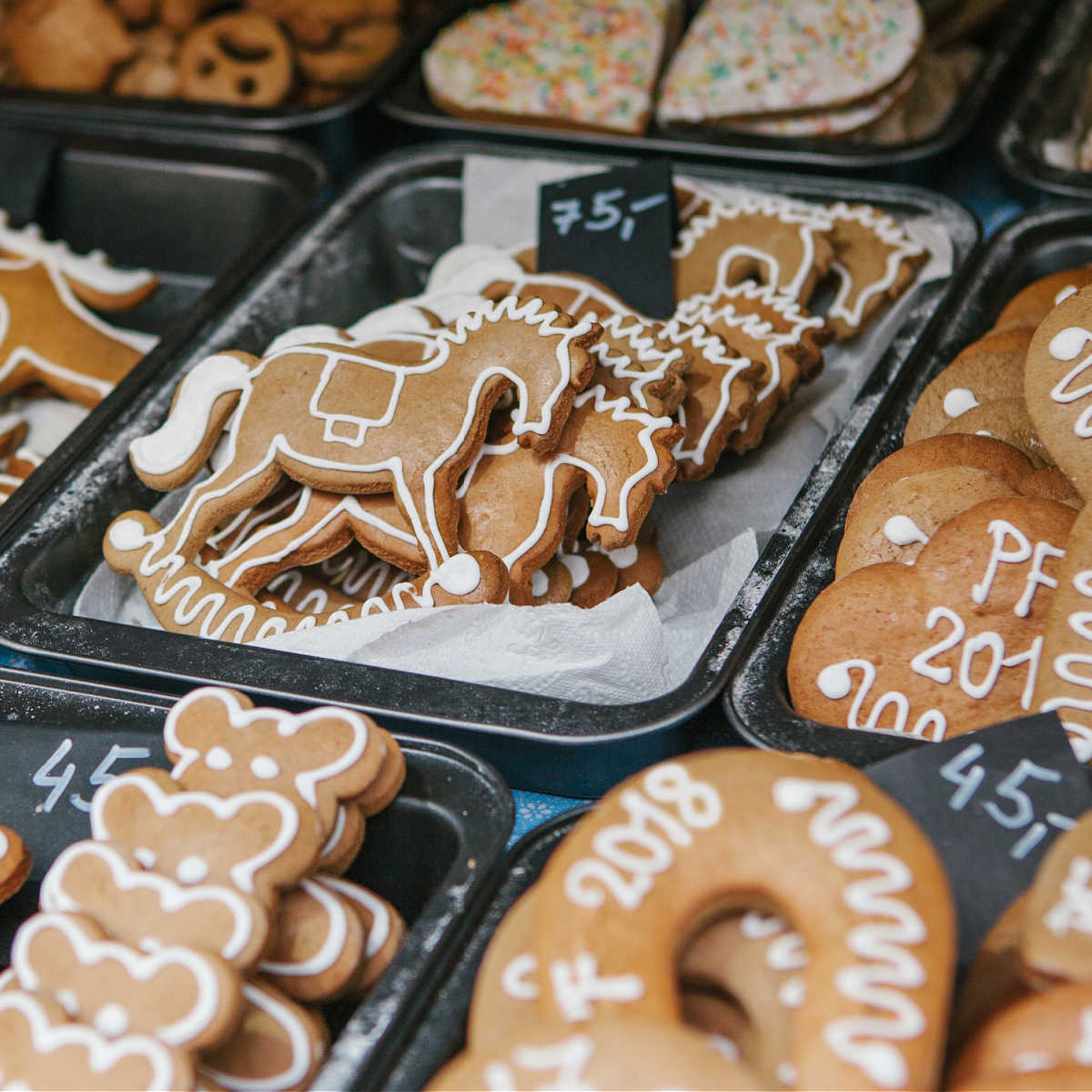
Today, you can buy a selection of traditional Czech Christmas cookies at supermarkets, local bakeries or Christmas Markets in Prague, but before 1989 you had to bake them at home. We would normally start about six weeks to a month before Christmas and bake gingerbreads first as they always needed a longer time to soften.
The rule was (in our house anyway), that you couldn’t eat the cookies until Christmas Eve, when we displayed the cookies on different trays and placed them around the kitchen and living room. At that point, the trays were always ‘replenished’ until we ran out, which usually wasn’t until well after New Year’s Day.

10. Christmas Sweet Bread (Vanocka)
Christmas sweet bread called ‘Vanocka – from Vanoce – Christmas’ is one of the traditional symbols of Czech Christmas. Its shape resembles baby Jesus in swaddling clothes and it was also believed that the cross braiding serves a protective function and protects people sitting at the table from evil forces.
The taste of Vanocka is fairly similar to a more substantial brioche, but Vanocka has also raisins, almonds and other dried fruits in the dough. The recipes vary from family to family, but my favourite recipe includes cream instead of milk, dried fruits, almonds and lemon zest in the dough.
Vanocka is a type of enriched dough, similar to the Easter Sweet Bread called Mazanec, made with white strong flour, yeast, sugar and milk or cream and dried fruits. The plating can be quite complex with several layers on top of each other depending on the size of the Vanocka. We would have the first Vanocka for breakfast on Christmas Eve and then through the whole Christmas.
To get closer to the real ‘Vanocka’ taste I’d recommend that you buy it at a bakery or farmer’s market rather than a supermarket. All the bakeries will start to bake Vanocka in mid November to early December and carry on baking it for the whole festive season.

11. Apple Slicing Custom
This custom should be done straight after Christmas Eve dinner. To find out what the future brings, just slice an apple crosswise. If you find a star inside the cut apple, you will be healthy and happy next year, otherwise, a cross or a worm indicates illness or death.
12. Pouring Lead Custom
One of the Christmas traditions is also pouring molten lead into water. The resulting casting is then used to predict the future for the person. If you want to try this tradition at home, you can buy ready-made sets for pouring lead which include everything needed, including a guide on what the resulting shapes may mean.

13. Floating Lights in a Walnut shell Custom
Another favourite folk tradition is to float walnut boats with a lit candle in a bowl or sink with water. How the boats behave can answer a question or predict the future. It is important that the person who asks the question makes the walnut boat themselves and floats it on the water.
Each person should have their own little walnut boat. If one boat drifts away from the rest, the person to whom the corresponding boat belongs will go out into the world. If the boats stay together, the family will stay together too.

14. Carp Scales custom
As you are preparing your Christmas Eve dinner, you are supposed to put a few carp scales under each plate. This brings everyone good fortune, money and abundance next year. When you finish your dinner, you should put the carp scale in your wallet or purse to bring you money in the next year.
15. Throwing a Shoe custom
This old folk custom was popular amongst young girls. Each girl would stand in the hallway or a room with her back to the door and throw a shoe or slipper over her shoulder.
If the shoe or slipper points with its toe towards the door, it means the girl will get married and leave home. If the toe does not point towards the door, she will not get married and stay at home for another year.

16. Fasting on a Christmas Eve custom
According to Czech tradition, if you don’t eat all day on Christmas Eve, you’ll see a golden piglet in the evening. Based on the tradition, your first food should be the Christmas Eve dinner which is then served when the first star appears in the sky (about 4-5 pm).
If you see a golden piglet being sold at the Christmas Markets in Prague, you will know why! People buy them for children or each other as a little fun gift, because even if you do fast on Christmas Eve, you are very unlikely to see an actual golden piglet.
17. Knocking on the Henhouse custom
According to folk custom, every single girl should knock with her shoe on the henhouse. If a hen responds, the girl will remain single, but if a rooster responds, the girl will soon get married. This is all well and good, but try finding a hen house in Prague!

18. Washing and Hanging Laundry custom
According to superstition, doing your laundry or washing on Christmas Eve brings bad luck. The same goes for hanging laundry, and whoever washes and hangs laundry will cause the death of someone in the family in the next year.
19. Advent candle wreath
Advent candle wreath with four candles symbolises the four Advent Sundays before Christmas Day. Each week we light up one extra candle until the last Sunday you light up all four.
Although most people think about choosing the colour of the candles based on what Christmas theme they are going for this year, the candle colours have their own meaning.
The colours are based on the religious denomination – the traditional Czech colours are three candles in purple colour and one pink (to symbolise hope and birth), Protestant churches choose red and gold colours and Anglican and Lutheran church uses blue colour.

20. Bethlehem Light
This is a relatively new but very lovely tradition, that’s getting more and more popular. This tradition was started in Austria in 1986 and it’s all about bringing home the light that’s shining in Bethlehem.
The Bethlehem Light is a symbol of hope, light that overcomes darkness, and the flame is also a symbol of peace.
Each year, the flame is brought from Bethlehem in Israel, where Jesus Christ was born according to Christian tradition, and as it travels throughout Europe people bring their own candles to light up from it and take them home.
In the Czech Republic, the scouts have been organising and distributing the light for over 30 years. The light travels on the train through the Czech Republic into all the main towns and in Prague, the light travels on a specially designated tram.
Each Prague or town area has a date and time when the light is available and you can come and light your candle. The light is also distributed to all the churches, so I usually go to St Wenceslas Church in Smichov as it’s closest and I walk back home with the light. It’s pretty magical…

Where and how to experience the Czech Christmas traditions
If you are planning your visit to Prague at the end of November or any time in December you only need to walk around the centre of Prague to start soaking up the Christmas atmosphere. The winter weather in Prague gets a little colder as the days go by and if you are in luck, you might even get snow!
My favourite ways to experience Christmas is to visit the Christmas markets and exhibitions in Prague and then head out from Prague to visit a few castles that always turn into a fairy tale setting for Christmas. I also really like the skanzen in Prerov as it always takes me back to when we used to spend time at our grandmother’s farmstead in the countryside.
- Christmas Markets – The Complete Guide to Prague Christmas Markets >>
- Nativy Scenes Exhibition – Bethlehem Chapel close to Old Town Square, Prague 1
- Christmas Exhibition – Botanical Garden, Na Slupy, Prague 2
- Nativity Scenes Exhibition – Franciscan Monastery at Jungmanovo Square, Prague 1
- Nativity Scenes Exhibition – Karlstejn Village, 30 minutes by train from Prague Smichov Train Station

Prerov nad Labem Skanzen
The skanzen in Prerov nad Labem is my favourite place to soak up the Christmas atmosphere and I always visit when the village is decorated for Christmas from mid November to 23 December.
There are a total of 33 folk houses in the museum, including 7 cottages, 7 barns, and 2 granaries. Each cottage is furnished with festive decorations and explanations about the different customs focusing on the life of rural people in the central Elbe region from the late 18th century to the mid-20th century.
- Location: Prerov nad Labem
- How to get there: regular buses no. 398 from Cerny Most (last stop on the Prague Underground Line B) takes about 30 minutes to stop at Prerov nad Labem – Rozcesti U Obory and then 20 minutes walk to the village.
- Opening Times: Tuesday – Sunday, 10 am -4 pm
- Ticket cost: 120 CZK adult 60 CZK children

Christmas at the Castles
Most castles close for the winter season at the end of October, but some re-open for special Advent tours, when you can see the castle rooms decorated for Christmas.
I’ve put together a practical guide to castles open in winter, which are reachable by public transport from Prague. This year, the castles at historic Trebon town (2 hrs by train from Prague), Krivoklat (1,5 hrs by train from Prague), Slatinany (just under 2 hrs by train) and Loucen (1,5 hrs) will be opening each weekend before Christmas.
Trebon is beautiful as a town and it’s also a place where most of the carp come from as there are many fishing lakes. The fishing lake areas around Trebon are also on the UNESCO list in Czech Republic, so it’s a pretty special place to visit before Christmas.
PIN FOR LATER

This blog post was originally written on 28 September 2023 and last updated on 2 September 2024






